GMS Field Trip July 2024
If you have any questions about field trips send email toGMS Field Trip
Hike, Picnic, and Gold Museum in Georgia
Saturday, July 13, 2024
When the subject of gold mining in Georgia comes up, the first place most people think of is Dahlonega, but Villa Rica has a rich history of gold mining too. Even its original name, Hixtown, was changed to Villa Rica, Spanish for “Village of Riches”, to reflect the abundance of gold there. The Pine Mountain Gold Mine was among the many gold mines that started (unofficially) in the area around the mid-1820s. Most of the mines continued operating until World War II. Others lasted until it became increasing difficult to extract gold, prompting many of the miners to abandon Villa Rica to look for gold in Dahlonega, and later, to join the California gold rush of 1849. The Pine Mountain Gold Mine continued operating on and off through the 1930s.
An excited group of GMS members arrived in Villa Rica on a balmy July morning, eager to learn about gold mining there. Wesley Berninger, Museum Director, started our trip with a hike through the woods to see ruins and other artifacts of gold mining. We stood among the ruins of a house where he introduced us to the history of the Stockmar family that once owned the property, then gave us a brief history of gold mining as it was done there. Hiking along a gravel trail, we stopped to peer down into a 62-foot-deep crater that was left behind from digging gold ore. Wesley said it is much larger and deeper than what we were seeing, and even has different plants at the bottom because it has its own microclimate. He showed us other places where mining occurred, and even let us take a quick peek into some shallow mineshafts. We could feel cool air wafting through the shafts, and we could still see marks where miners’ tools had struck the quartz. Cameron Clines examined the walls with a UV flashlight, longwave and shortwave, and found a fluorescent mineral that energized the juniors on the tour.
Quartz rocks dotted the ground everywhere we went. They were even embedded in the ruins of the Stockmar house. The quartz has a very grainy appearance and some of it appears to be loosely consolidated, so we could see how easy it would be to crush it (click here for Georgia Bulletin B-107, pp. 22-24, for more information about the geology as it relates to gold in the Villa Rica district). Wesley explained how miners did indeed crush quartz rocks, then used cyanide and mercury to extract fine particles of gold, some of the purest in the world, as high as 98 percent pure. As we continued along the trail, we saw concrete structures that once held gold ore, water, and cyanide. Still standing in the woods after more than 100 years, the structures were made of a concrete mix of rocks and sand from the mine tailings, and reinforced with whatever scrap metal the builders could find, including barbed wire and clothes hangers. Now, they are mostly empty except for some native plants and one very angry bullfrog.
Because iron was desperately needed to produce steel during World War II, many of the artifacts made of iron that could have been at the mine are gone. Wooden artifacts tend to decay, so very little wood remains either. It is remarkable how many artifacts the museum has been able to find and preserve, including the skeletal remains of an ore gondola that is now on display in the museum, and a stamp mill that sits outside the museum. A stamp mill consists of heavy steel rods called “stamps” that are lifted by cams on a rotating shaft. As the stamps drop, they crush ore into sand-sized particles that can then be processed to extract the gold. Parts of the stamp mill were found on the property and pieced back together. Careful sourcing of rare components were the last pieces of the puzzle to get the mill running again. The museum uses the stamp mill to crush ore from the property for their gold panning activity. Wesley ran the stamp mill for us so we could see how it operates. Juniors enjoyed the roar of the machinery and the banging of the stamps as water gurgled out carrying crushed ore with it. They were fascinated by the up and down movement of the stamps.
After the excitement of the stamp mill, we headed for the picnic pavilion. Early that morning, Cameron Clines started up the charcoal grill in the pavilion, so when we returned from the hike, the charcoal was perfect. He grilled up a pile of burgers and hotdogs provided by GMS to go along with the potluck dishes and desserts that members brought. Since we would not be collecting that day, Kim Cochran put together some door prizes for us. Everyone was surprised and thrilled with their prizes. Members helped each other identify specimens, and juniors enjoyed seeing what everybody received. The delightful picnic lunch gave everyone a chance to relax, cool off, chat with each other, and refuel for the next phase of the trip – the gold museum.
Amy Collerton, archivist and historian at the museum, walked us through museum displays filled with artifacts and placards that tell the story of gold in Georgia from a Villa Rica perspective. Amy explained that the people mining for gold there were not professional miners. They were farmers and other local people infected with the gold fever that possessed many along the Georgia gold belt. Unlike Dahlonega, where the discovery of gold was shouted from the hills, gold in Villa Rica was a quiet affair, so Amy had to do a tremendous amount of historical sleuthing to dig up even small nuggets of information. Based on reports and records that she cross-referenced and correlated with known timelines, Amy determined that gold was found and actively mined in the Villa Rica area a few years before it was reported in Dahlonega. Until December 1829, any gold found in Georgia belonged to the state. Therefore, gold was being mined unofficially, i.e., illegally, in Villa Rica in 1826. After the law was repealed in 1829, mineral rights were granted to counties in Georgia, who then sold land lots and voila – suddenly several gold mines were deeded in Villa Rica.
Some artifacts unique to the site are on display in the museum. Of particular note are two items invented by Buddy Stockmar, the owner of the property until his death in 1974. Buddy’s innovative t-shaped bricks were manufactured on site with sand from mine tailings. The “T” shape allowed mortar and reinforcing rods to be placed inside masonry walls, adding strength and making construction faster. They were used for buildings in downtown Villa Rica, and can still be seen in buildings on museum property.
During World War II, low-cost cargo ships called “Liberty Ships” were mass-produced to deliver critical supplies and provide troop transport. The ship hulls were once built with rivets, but riveting was time-consuming, expensive, and required a great deal of strength, skill, and labor. Amy and Wesley explained that Buddy invented a device called a “Jack Clamp” to replace the need for rivets by holding hull plates together so they could be welded in place, but didn’t require the upper body strength that riveting did. The process was faster, cheaper, and easier than riveting. Jack Clamps enabled women and minorities, people who normally would not have been employed by shipyards, to replace workers who were away due to the war. Amy wrote, “The women and minorities inducted into the American workforce during World War II gained experience and inspiration, directly resulting in changes to racial and gender conventions in the following 2 decades.” Because the clamps were considered disposable, and because they were made of iron, they were probably recycled or corroded to oblivion, so very few have survived. The Pine Mountain Gold Museum is possibly the only place you can see a Jack Clamp.
Something else you are not likely to see anywhere else is a fun display of “rocks and minerals” from books, comics, and movies. Many, many, fictional stones are well represented including the kryptonite that threatens Superman; pet rocks from the 70s; Star Trek dilithium crystals; Pokemon Evolution Stones; Infinity Stones from the Marvel Comics universe; and more. The clever display captivated young and old as we pointed out the stones and references that each of us recognized. The trip concluded with members milling around the displays and chatting with Amy and Wesley, who were always available to answer questions and regale us with tales of the past. It was an action-packed day and the museum was a wonderful way to end the trip, but juniors were still excited, so they finished up with some gold panning and gem grubbing!
Many, many thanks to Wesley and Amy who warmly embraced us and taught us about geology, gold mining, and local history. They were overflowing with historical tidbits and tales, and enthusiastically shared their knowledge. Thank you to Cameron Clines for bringing burgers, hotdogs, buns, and all the supplies for grilling as well as being an excellent grill master. Everyone enjoyed all the delicious dishes and snacks that members brought for the picnic too. We sincerely appreciate all the work Kim Cochran did to put together outstanding door prizes for the trip. Thank you to the members who sent me pictures for this report -- Cristina Clines, Ken Scher, and especially Martha Carroll, whose careful pictorial documentation of the trip helped me get several facts correct. And, of course, Charles Carter put a lot of work into arranging this trip, so we definitely owe him a big “thank you” for all that he did as well.
Lori Carter on behalf of Charles Carter
e-mail:
History Hike
Photo by Cristina Clines

Ruins of the Stockmar house
Photo by Lori Carter
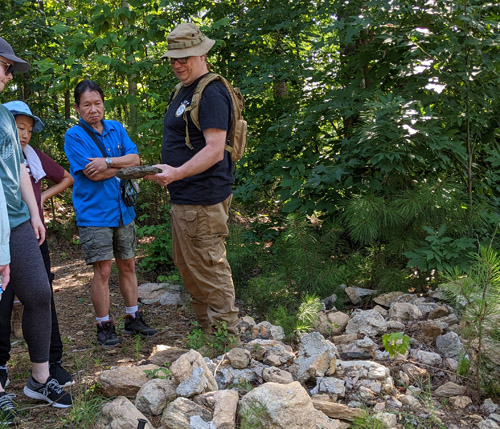
Wesley showed us native rocks and explained some of the mining techniques used to extract gold from them
Photo by Lori Carter
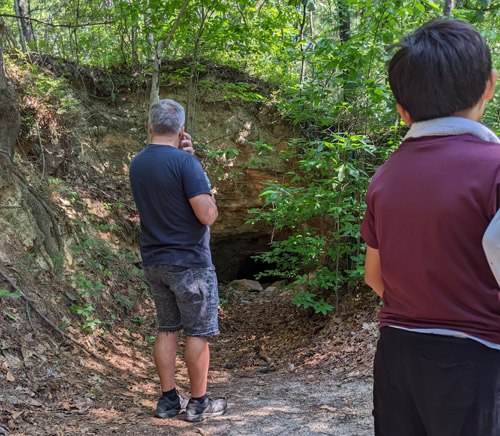
A "man-way tunnel" that was used as a shortcut for miners to get across the mine
Photo by Martha Carroll

Photos by Lori Carter

Peering into a water reservoir tank
Photos by Lori Carter



Wesley pointed out a quartz outcropping on the trail.
We could see how grainy it is and how easily it can break apart.
Photos by Lori Carter


Checking out a sump tank that would contain water with cyanide in it
Photo by Lori Carter

Photo by Martha Carroll

Photo by Lori Carter

Cyanide dissolving tank
Photo by Lori Carter

The reinforcing metal in this tank is causing the concrete to fall apart.
There was an angry bullfrog in there plus some amazing acoustics.
Photos by Lori Carter



Getting a closer look at some shallow mining shafts.
Photos by Lori Carter



Cameron Clines found a fluorescent mineral
Photo by Cristina Clines

Photos by Lori Carter


Stamp mill
Photos by Lori Carter

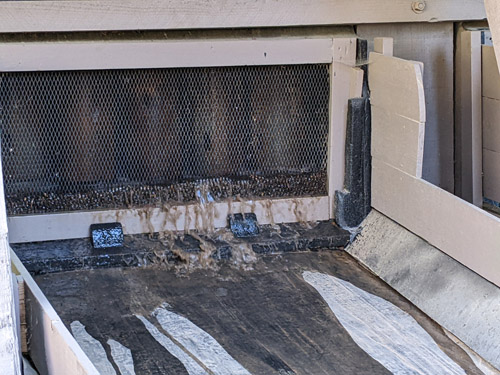

The heavy rods, called stamps, crush ore into sand-sized particles
Photos by Lori Carter

An original ore car survived in the Stockmar family's living room
Picnic!
Photos by Lori Carter


Photo by Martha Carroll

Cam grilled hotdogs and burgers and everyone brought sides and desserts
Photos by Lori Carter


Pretty dendritic slab door prize
Photos by Lori Carter


More door prize slabs
Photos by Lori Carter
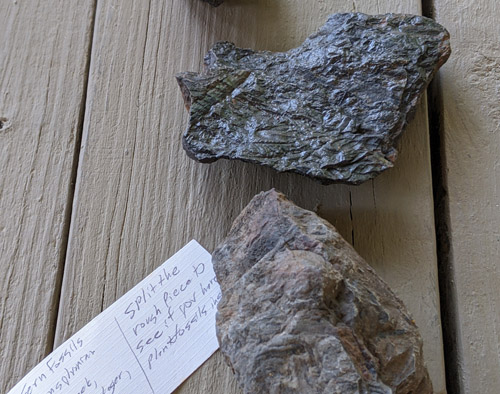



Juniors were excited about their door prizes -- fossilized ferns, amethyst clusters,
polished garnets plus natural corundum crystals, and a beautiful amethyst crystal
Photos by Lori Carter

Everyone drooled over this crinoid calyx door prize!
Pine Mountain Gold Museum
Photo by Ken Scher
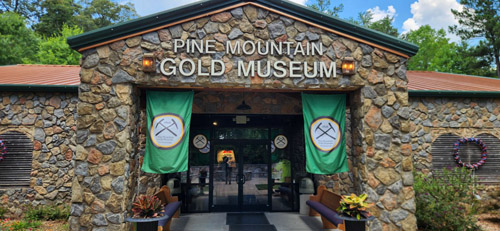
Preserving the history of the Pine Mountain Gold Mine and gold mining in Villa Rica
Photos by Cristina Clines
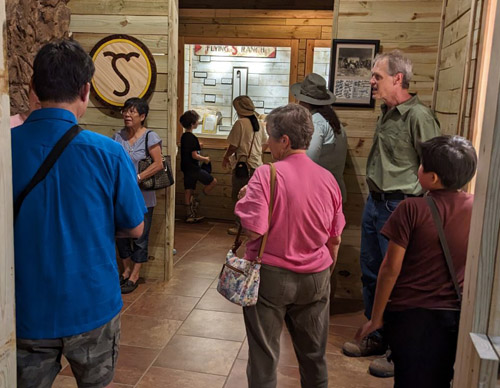

Photo by Lori Carter

Amy walked us through the museum displays telling us tons of historical tales and tidbits
Photo by Martha Carroll

This banjo was handmade by one of the miners at the Pine Mountain Mine and undoubtedly entertained many miners
Photos by Lori Carter

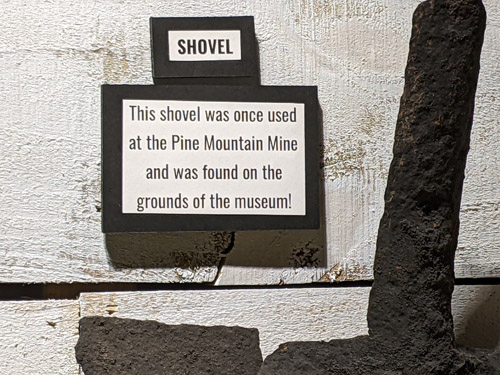
Another artifact from the gold mine
Photo by Martha Carroll

Someone else was visiting the museum...
Photos by Lori Carter


Buddy Stockmar invented the Jack Clamp, a device that changed the course of history is many ways
Photos by Lori Carter


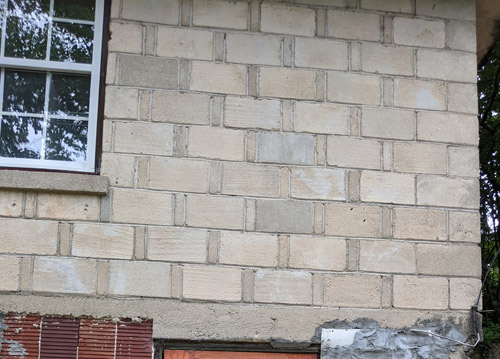
Buddy also invented an innovative t-shaped brick
Photos by Cristina Clines


Everyone enjoyed the displays
Photo by Cristina Clines

Photo by Martha Carroll

This display of fictional stones captivated all ages
Photo by Cristina Clines

We exited the display area through a mine shaft opening!
Flora, Fauna, and a Few Extras
Photos by Lori Carter


Pretty flowers along the walk.
Some rare flowers weren't blooming that day, but we saw white flags marking them.
Photo by Lori Carter
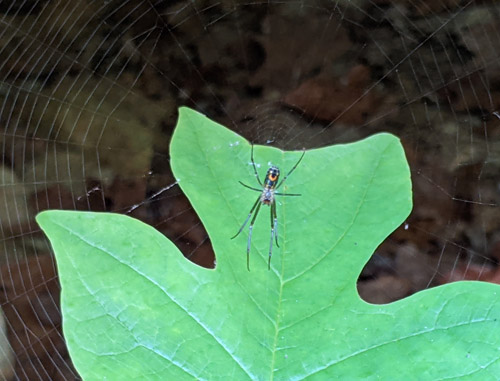
A junior spotted this little guy
Photos by Lori Carter



Even the restrooms are educational!
Tiles in the restrooms depict various scenes, for example:
indigenous people of the area, miners working a sluice, and the museum's stamp mill!
Click below for field trip policies

Copyright © Georgia Mineral Society, Inc.
